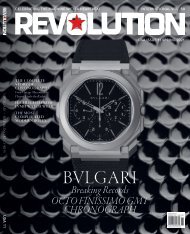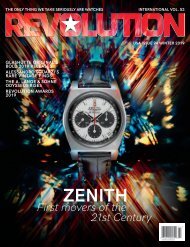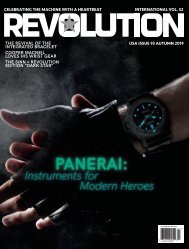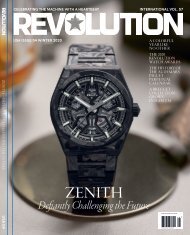You also want an ePaper? Increase the reach of your titles
YUMPU automatically turns print PDFs into web optimized ePapers that Google loves.
LEFT<br />
Each time polishing<br />
is done, it removes<br />
material from the<br />
original case, which<br />
can result in noticeable<br />
differences such as<br />
the spacing between<br />
the notched bezel.<br />
RIGHT<br />
A closeup of the 1675<br />
OCC PCG’s dial shows<br />
the cracking of the<br />
varnish on the dial,<br />
a “spider webbing”<br />
that extends across<br />
most of the dial now.<br />
proposed) to make up for the decade of heartache and substantial<br />
financial loss resulting from the damn watch, was tempting. I even sent<br />
the image of the watch to Paul Boutros at Phillips who immediately<br />
spotted the incorrect bezel. In the context of last year when the idea<br />
was put forward, I found myself in sudden need of cash, and so the idea<br />
of auctioning the watch gained appeal. After all, apparently everyone<br />
was doing it. Indeed we went back and forth about the watch with<br />
him showing it to his contacts, but with no one biting. His reputation<br />
had clearly been affected as a result of the legal action. But the more I<br />
thought about it, the more I couldn’t live with the idea of being complicit<br />
in the very thing that had been perpetuated upon me, regardless of the<br />
profit, which was essentially to sell a watch under false pretenses.<br />
RIGHTING IMPERFECTION<br />
I understood that the watch is now ostensibly correct. It has the right<br />
and super rare dial, right hands, movement, case and even bracelet.<br />
It comes with box and papers and supporting documentation — but<br />
it wasn’t born that way. It was created to generate a highly profitable<br />
narrative. Finally, its NOS condition was also a falsehood as it was<br />
created specifically to look like an old, unmolested watch when it was<br />
anything but. Indeed, if anything, at the moment the case looks a little<br />
too new, which jars with the clearly aged and patinated dial, which,<br />
under magnification, shows the faint traces of “spider webbing”, or<br />
cracks in the surface varnish. It was J who alerted me to the fact that the<br />
watch had been rejected by many of his buyers because of this spider<br />
webbing. This confused me as, being someone obsessive compulsive<br />
about details, it was a detail I would have noticed before the watch<br />
became part of this complex swapping of parts. And then it dawned on<br />
me that I hadn’t really looked at the watch since it was restored.<br />
At the end of last year, J passed me the Rolex and, quite honestly,<br />
I wasn’t particularly motivated to look at it. Then, as I solidified my<br />
resolve to not sell the watch and use it as the basis of this story, I<br />
decided to take it out of the safe and start photographing it. Now once<br />
its serial numbers are shown to the world, as I have every intention<br />
of doing, the watch will, for all intents and purposes, be unsellable as<br />
it will be a matter of public record that it has been the focus of both<br />
Frankenwatching and also an attempt to bring it back to NOS quality.<br />
So once I made peace with the fact that my five-digit sterling investment<br />
in this watch was to be reduced to zero, I informed J that we would not<br />
be selling the watch and that I was going to go public with the entire<br />
story behind it. That was when something really disturbing happened.<br />
As my team and I began to examine the watch in earnest and<br />
take microscopic photographs of its details, we discovered that the<br />
“spiderweb” cracking on the varnish of the dial was pervasive and<br />
covered the entire dial — something I was certain was not there before<br />
this entire process began. Just as disastrous, it appears that J never even<br />
had the case laser welded before it was recut, because the bevel on the<br />
bottom right lug is now touching the hole for the spring bar — meaning<br />
that, in his laziness, he hadn’t even bothered to have this area built back<br />
up. Indeed if you look at the profile of the case, you would be able to see<br />
that the distance between the spring-bar hole on the upper-right lug is<br />
farther from the bevel, meaning there is more material between these<br />
two elements than in the lower right. What J had described as a NOS<br />
watch was essentially a badly botched facelift. In the end, a palpable<br />
sense of relief washed over me as I had almost played a part in trying to<br />
pass off a poorly — I would even say laughably — refinished watch as<br />
something that was in original condition.<br />
So where does this leave me? Well firstly, I hope that sharing this<br />
information with you has made you a little more circumspect and<br />
discerning about vintage watches, and that you understand that if these<br />
technologies can be used for Rolexes, they can also be used for Pateks or<br />
anything else of value. Indeed I know of one Italian dealer who famously<br />
and very proudly had the case of a pink-gold 2499 recut. Hopefully, this<br />
will be something of a wakeup call to the vintage watch industry and they<br />
will begin to put in place greater safeguards and transparency.<br />
Is there a way to avoid the pitfalls that I experienced? Well, the old<br />
146 VINTAGE











